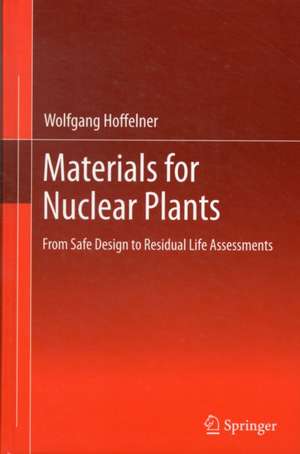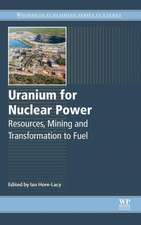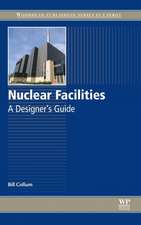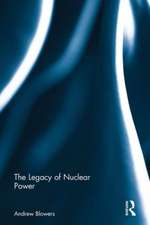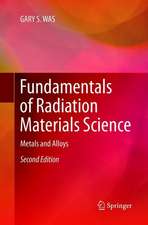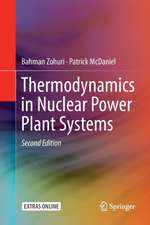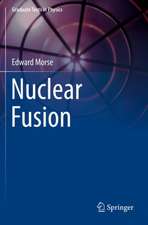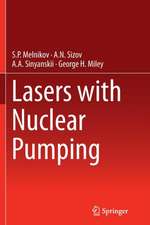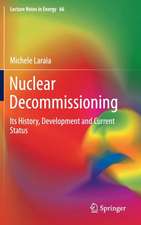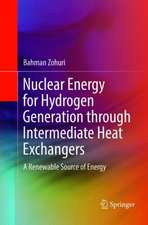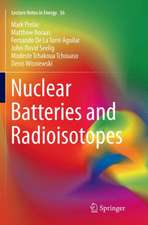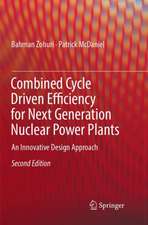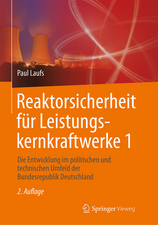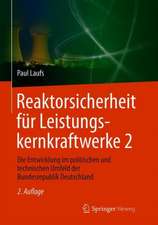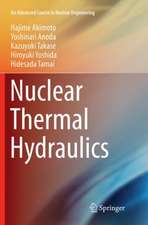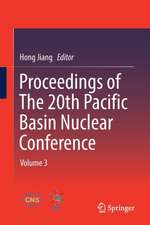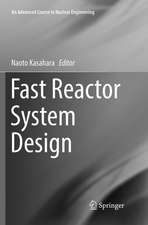Materials for Nuclear Plants: From Safe Design to Residual Life Assessments
Autor Wolfgang Hoffelneren Limba Engleză Hardback – 21 sep 2012
Materials for Nuclear Plants: From Safe Design to Residual Life Assessments approaches structural materials with a systemic approach. Important components and materials currently in use as well as those which can be considered in future designs are detailed, whilst the damage mechanisms responsible for plant ageing are discussed and explained. Methodologies for materials characterization, materials modeling and advanced materials testing will be described including design code considerations and non-destructive evaluation concepts.
Including models for simple system dynamic problems and knowledge of current nuclear power plants in operation, Materials for Nuclear Plants: From Safe Design to Residual Life Assessments is ideal for students studying postgraduate courses in Nuclear Engineering. Designers on courses for code development, such as ASME or ISO and nuclear authorities will also find this a useful reference.
| Toate formatele și edițiile | Preț | Express |
|---|---|---|
| Paperback (1) | 1384.88 lei 6-8 săpt. | |
| SPRINGER LONDON – 15 oct 2014 | 1384.88 lei 6-8 săpt. | |
| Hardback (1) | 1388.64 lei 6-8 săpt. | |
| SPRINGER LONDON – 21 sep 2012 | 1388.64 lei 6-8 săpt. |
Preț: 1388.64 lei
Preț vechi: 1693.46 lei
-18% Nou
Puncte Express: 2083
Preț estimativ în valută:
265.73€ • 284.14$ • 221.55£
265.73€ • 284.14$ • 221.55£
Carte tipărită la comandă
Livrare economică 17 aprilie-01 mai
Preluare comenzi: 021 569.72.76
Specificații
ISBN-13: 9781447129141
ISBN-10: 1447129148
Pagini: 482
Ilustrații: XXX, 482 p.
Dimensiuni: 155 x 235 x 33 mm
Greutate: 0.82 kg
Ediția:2013
Editura: SPRINGER LONDON
Colecția Springer
Locul publicării:London, United Kingdom
ISBN-10: 1447129148
Pagini: 482
Ilustrații: XXX, 482 p.
Dimensiuni: 155 x 235 x 33 mm
Greutate: 0.82 kg
Ediția:2013
Editura: SPRINGER LONDON
Colecția Springer
Locul publicării:London, United Kingdom
Public țintă
ResearchCuprins
Preface.- Introduction.- 1.Nuclear Plants.- 2.Materials.- 3.Components and Production.- 4.Mechanical Testing of Nuclear Materials.- 5.Irradiation Damage.- 6. Environmental damage in Nuclear Plants.- 7. Advanced Mechanical Testing and Analysis Methods.- 8. Design, Life-time and Residual Life.
Notă biografică
Wolfgang Hoffelner is currently leader of the High Temperature Materials group at the Swiss Paul Scherrer Institute performing research on structural materials for nuclear plants. He is also Managing Director of RWH consult Llc., a Swiss based consulting company for materials and energy related questions. He represents Switzerland in different Generation IV Committees and he acts as task advisor and materials data analyst for ASME Llc.
Wolfgang Hoffelner has been Senior Lecturer for High Temperature Materials at the Swiss Federal Institute of Technology since 1986 and he is currently responsible for the materials education within the Swiss Master of Nuclear Engineering Program. He received his PhD in Physics and his MS in mathematics from the University of Vienna. He started his work as a research fellow at the same place with research work on microstructural stability of advanced nickelbase alloys. He improved his skills in structural materials and mechanics during his timeat ABB (formerly BBC) where he was working in different positions. He started in 1977 as a scientist in the Research Laboratory where he studied crack growth of high temperature materials under fatigue, creep and high temperature corrosion. Later he became Group Leader (creep and fatigue) in the Metallurigal Laboratory and Head of Section Mechanics and Materials for Gas Turbines and Combined Cycle Plants. 1990 he joined the Swiss Company MGC-Plasma Inc. as a Board member where he was responsible for technology of metallurgical and environmental applications (including low level nuclear waste) of thermal plasma. Wolfgang Hoffelner is member of ASME, ASM and TMS and he has published more than 130 papers in scientific and technical books and journals.
Dr. Hoffelner has recently been awarded the 2012 Staudinger-Durrer medal of the Swiss Federal Institute of Technology in Zurich for important services to the Department of Materials and excellent teaching of materials science.
Wolfgang Hoffelner has been Senior Lecturer for High Temperature Materials at the Swiss Federal Institute of Technology since 1986 and he is currently responsible for the materials education within the Swiss Master of Nuclear Engineering Program. He received his PhD in Physics and his MS in mathematics from the University of Vienna. He started his work as a research fellow at the same place with research work on microstructural stability of advanced nickelbase alloys. He improved his skills in structural materials and mechanics during his timeat ABB (formerly BBC) where he was working in different positions. He started in 1977 as a scientist in the Research Laboratory where he studied crack growth of high temperature materials under fatigue, creep and high temperature corrosion. Later he became Group Leader (creep and fatigue) in the Metallurigal Laboratory and Head of Section Mechanics and Materials for Gas Turbines and Combined Cycle Plants. 1990 he joined the Swiss Company MGC-Plasma Inc. as a Board member where he was responsible for technology of metallurgical and environmental applications (including low level nuclear waste) of thermal plasma. Wolfgang Hoffelner is member of ASME, ASM and TMS and he has published more than 130 papers in scientific and technical books and journals.
Dr. Hoffelner has recently been awarded the 2012 Staudinger-Durrer medal of the Swiss Federal Institute of Technology in Zurich for important services to the Department of Materials and excellent teaching of materials science.
Textul de pe ultima copertă
The clamor for non-carbon dioxide emitting energy production has directly impacted on the development of nuclear energy. As new nuclear plants are built, plans and designs are continually being developed to manage the range of challenging requirement and problems that nuclear plants face especially when managing the greatly increased operating temperatures, irradiation doses and extended design life spans. Materials for Nuclear Plants: From Safe Design to Residual Life Assessments provides a comprehensive treatment of the structural materials for nuclear power plants with emphasis on advanced design concepts.
Materials for Nuclear Plants: From Safe Design to Residual Life Assessments approaches structural materials with a systemic approach. Important components and materials currently in use as well as those which can be considered in future designs are detailed, whilst the damage mechanisms responsible for plant ageing are discussed and explained. Methodologies for materials characterization, materials modeling and advanced materials testing will be described including design code considerations and non-destructive evaluation concepts.
Including models for simple system dynamic problems and knowledge of current nuclear power plants in operation, Materials for Nuclear Plants: From Safe Design to Residual Life Assessments is ideal for students studying postgraduate courses in Nuclear Engineering. Designers on courses for code development, such as ASME or ISO and nuclear authorities will also find this a useful reference.
Materials for Nuclear Plants: From Safe Design to Residual Life Assessments approaches structural materials with a systemic approach. Important components and materials currently in use as well as those which can be considered in future designs are detailed, whilst the damage mechanisms responsible for plant ageing are discussed and explained. Methodologies for materials characterization, materials modeling and advanced materials testing will be described including design code considerations and non-destructive evaluation concepts.
Including models for simple system dynamic problems and knowledge of current nuclear power plants in operation, Materials for Nuclear Plants: From Safe Design to Residual Life Assessments is ideal for students studying postgraduate courses in Nuclear Engineering. Designers on courses for code development, such as ASME or ISO and nuclear authorities will also find this a useful reference.
Caracteristici
Examples and solutions help the reader learn quickly Includes information on current nuclear power plants to ensure readers' knowledge is up-to-date Shows how to model simple system dynamics problems Includes supplementary material: sn.pub/extras
